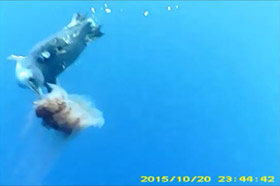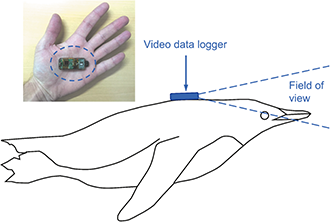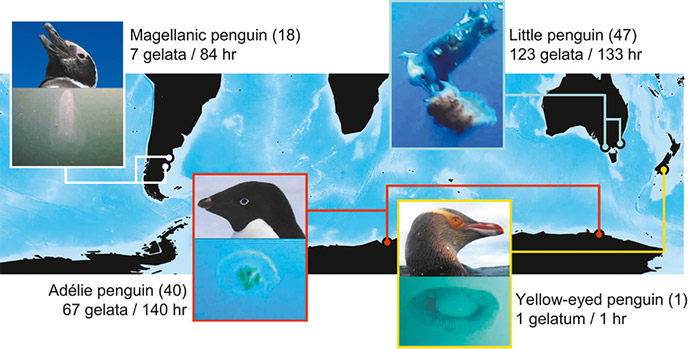National Institute of Polar Research
Jellyfish and other gelata as food for four penguin species – insights from predator-borne videos
Jellyfish are a more widespread food for marine predators including penguins, videos show
Released on September 22, 2017 (in Japanese)
Posted on September 29, 2017
National Institute of Polar Research

Jellyfish and other pelagic gelatinous organisms (“gelata”) are perceived as an important component of marine food webs but remain difficult to study. Using miniaturized animal-borne video data loggers on 106 penguins from 4 species across 7 sites in the southern hemisphere, we documented nearly 200 cases of attacks on gelata by the four penguin species, at all seven localities. Our findings emphasize that gelatinous organisms actually represent a widespread food source across the southern oceans.
Figure 1, movie: Penguin-borne video-loggers show interactions with gelata.
It is a hard task to study gelatinous marine animals such as jellyfish. For this reason, their role in the oceans is extremely difficult to assess accurately. Especially, knowing to what extent they may serve as food for predators is challenging, because their soft, fragile structure cannot be identified accurately when examining the stomach contents of the predators, unlike harder pieces such as fish bones or squid beaks. Of course, some predators are famous for eating mostly these gelatinous animals (ocean sunfish, some sea turtles), but researchers are now interested in determining if more predator species may, at least sometimes, also consume them, and hence better understand the role of gelatinous animals in the ecosystems.

Figure 2: Illustration of one type of video data logger used in this study (Little Leonardo DVL200; 15 gr; dimensions: 20 mm × 10 mm × 52 mm; 2.5-hr recording capacity), and its position when attached onto the back of a penguin to monitor feeding events.
Newly developed video data loggers have now become sufficiently miniaturized to be attached on marine animals to visualize what kind of food, and in which quantity, they are capturing when they go feeding at sea. This study technique can hence provide detail about the importance of food items in the oceans, which other techniques could not provide so far. For example, other modern approaches using DNA in fecal samples of predators, or analyzing the stable isotope ratios in the predators’ tissues, found that the list of jelly-eating predators may be longer than we thought, but these approaches cannot rule out that the predators only accidentally ingested the jellyfish, while targeting another type of prey nearby. Now, with the video loggers, this limitation is lifted for the first time.
An international team of researchers, from France, Japan, Australia, Argentina and New-Zealand coordinated their efforts to deploy video loggers on an impressive number of 106 penguins, from 4 species (Adélie Pygoscelis adeliae, yellow-eyed Megadyptes antipodes, Magellanic Spheniscus magellanicus and little Eudyptula minor penguins), at seven breeding localities across regions of the southern oceans ranging from polar to temperate habitats. These efforts brought over 350 hours of footage, that was screened in order to precisely document the prey that were eaten by each individual penguin.
The researchers, who published their results in the journal Frontiers in Ecology and the Environment (article online on 5 September 2017), were surprised to see that individuals from all studied penguin species, at all localities, consumed at least one gelatinous animal over the short recording duration (1.5 to 5 hours) of the video recorders. The total number of attacked gelatinous animals (mostly jellyfish, but also ctenophores, the “comb jellies”) approached 200. Some penguins even attacked repeatedly jellies during their foraging trip, showing that this was not done by mistake on the first time; and the captures were obtained for some sites during successive years, suggesting that this behavior was not due to strange conditions during a given year.
The results of this study are important because they show not only that more marine predators feed on jellies than previously expected in the oceans, but also that jellyfish and other gelatinous animals may be attacked by penguins even when other, previously known prey are available for the predators. In other words, it is not because their favorite food is not available that penguins start to eat jellies.

Figure3: Map of the seven localities for the four penguin species surveyed across the southern oceans. For each species, the number of individual penguins instrumented with video loggers, the number of observed interactions with gelata (jellyfish or ctenophore), and the amount of recorded footage (hours) are indicated. The gelatum images were taken from the analyzed videos.
Then, why eating jellyfish? These gelatinous animals are renowned for their low energy content indeed (95-98% of their wet mass is water and salt), compared with other prey such as crustaceans or fish. The authors of the study provide four hypotheses. First, the low energy reward of gelatinous prey for penguins might be balanced by their ease of capture as compared with fish, which require greater effort to chase, manipulate, and assimilate. Second, predators may be selecting specific gelatinous tissues, such as gonad or arm tissues, which have an energy density about five times that of the bell. Preliminary studies using video loggers, published last year by the authors indeed supported this hypothesis. Third, the consumed jellies are themselves carnivores, and the small animals that they capture and start to assimilate may be a good concentration of food to target for the penguins, if they eat in priority the tissues where these small prey are assimilated by the jellies. Finally, the authors suggest that penguins may eat jellies not for energetic purposes, but because these gelatinous animals may bring some elements that can benefit to the penguins by enhancing physiological or biochemical processes. This hypothesis, however, needs additional investigation, with the detailed analysis of the biochemical components of the jellies. As recently evoked by Hamilton (2016), the jellyfish could indeed be “the green tea of the sea”.
The authors of this study are thus interested in measuring the biochemical composition of these jellyfishes and comb jellies, in detail, to clarify why they would be an interesting food source for penguins. For now, they are continuing using the video data loggers on a wide range of marine predators around the globe, to see the unseen among the predator-prey relationships in the World’s oceans.
- Jean-Baptiste Thiebot, PhD., National Institute of Polar Research.
Acknowledgement:
Logistic and financial support were provided by: Institut Paul-Émile Victor (program #1091), Zone Atelier Antarctique (CNRS), WWF-UK, Japanese Antarctic Research Expedition, Japan Society for the Promotion of Science (JSPS) Bilateral Joint Research Project, JSPS KAKENHI Grant Numbers JP26840153, JP24681006, JP16H06541, and JP17H05983, University of Otago Research Grant, National Agency for Scientific and Technological Promotion (Argentina), Conservation Agency from Chubut Province, National Research Council of Argentina (CONICET), and Parks Victoria (Australia). We thank DJ Lindsay (Japan Agency for Marine-Earth Science and Technology), G Bigatti (IBIOMAR-CONICET), and J Monk (Deakin University) for their help in the identification of gelatinous organisms, and JDR Houghton for comments on an earlier version of this manuscript.
Published Paper
Journal: Frontiers in Ecology and the Environment
Title: Jellyfish and other gelata as food for four penguin species – insights from predator-borne videos
Authors:
Jean-Baptiste Thiebot1, John PY Arnould2, Agustina Gómez-Laich3, Kentaro Ito4, Akiko Kato5, Thomas Mattern6, Hiromichi Mitamura7, Takuji Noda7, Timothée Poupart2,5, Flavio Quintana3, Thierry Raclot8, Yan Ropert-Coudert5, Juan E Sala3, Philip J Seddon6, Grace J Sutton2, Ken Yoda9, and Akinori Takahashi1,4
1 National Institute of Polar Research, Tokyo, Japan
2 School of Life and Environmental Sciences (BurwoodCampus), Deakin University, Geelong, Australia
3 Instituto de Biología de Organismos Marinos (IBIOMAR-CONICET), Puerto Madryn, Argentina
4 Department of Polar Science, SOKENDAI (The Graduate University for Advanced Studies), Tokyo, Japan
5 Centre d’Études Biologiques de Chizé, UMR 7372 CNRS et Université de La Rochelle, Villiers-en-Bois, France
6 Department of Zoology, University of Otago, Dunedin, New Zealand
7 Graduate School of Informatics, Kyoto University, Kyoto, Japan
8 Institut Pluridisciplinaire Hubert Curien – Département Écologie, Physiologie et Éthologie, Université de Strasbourg – CNRS UMR7178, Strasbourg, France
9 Graduate School of Environmental Studies, Nagoya University, Nagoya, Japan
URL:http://onlinelibrary.wiley.com/doi/10.1002/fee.1529/abstract
DOI:10.1002/fee.1529
First published: September 5, 2017
Contact
Public Relations Section, NIPR
E-mail: kofositu@nipr.ac.jp








